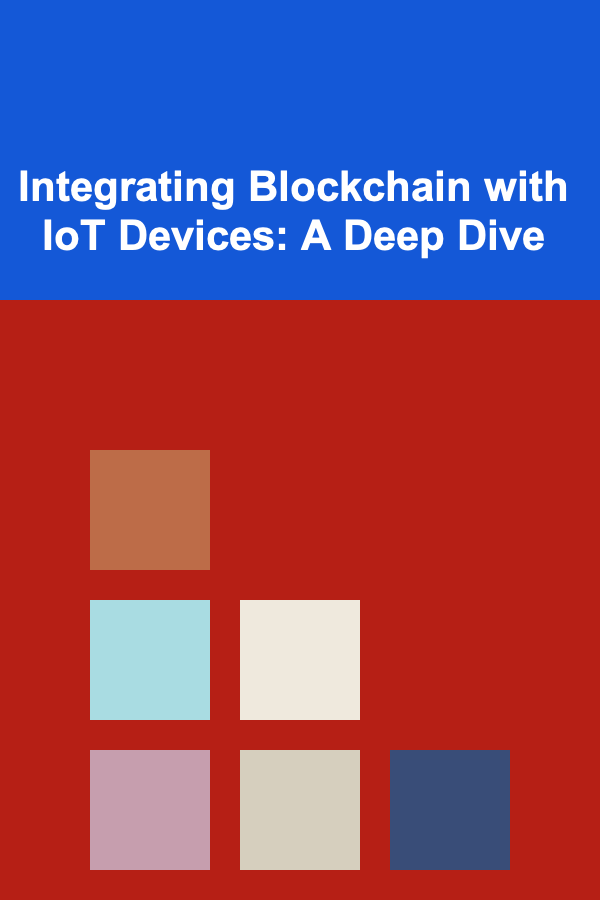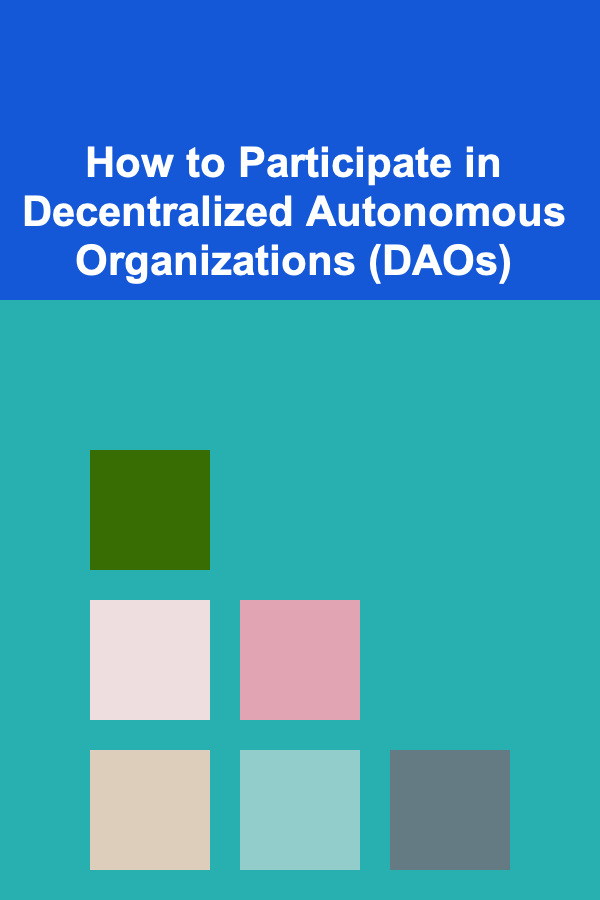
Integrating Blockchain with IoT Devices: A Deep Dive
ebook include PDF & Audio bundle (Micro Guide)
$12.99$11.99
Limited Time Offer! Order within the next:

The Internet of Things (IoT) has revolutionized various sectors by connecting everyday objects to the internet, enabling data exchange and automation. However, the exponential growth of IoT devices has also amplified concerns regarding security, privacy, and scalability. Blockchain technology, with its decentralized, immutable, and transparent nature, offers a promising solution to address these challenges. Integrating blockchain with IoT devices can create a more secure, efficient, and trustworthy ecosystem. This article explores the intricacies of this integration, delving into its benefits, challenges, architectures, and future trends.
The Convergence of IoT and Blockchain: A Synergistic Relationship
IoT generates massive amounts of data from connected devices. This data is often centralized, making it vulnerable to single points of failure, data breaches, and manipulation. Blockchain provides a distributed ledger that ensures data integrity and immutability. Furthermore, blockchain's smart contract functionality enables automated and secure interactions between IoT devices, reducing the need for intermediaries and enhancing trust.
Consider a supply chain scenario: IoT sensors track the location and condition of goods in real-time. By integrating this data with a blockchain, every transaction and environmental reading is recorded immutably. This allows all stakeholders to verify the provenance and integrity of the goods, reducing counterfeiting and improving transparency. Similarly, in smart homes, blockchain can secure data from smart appliances and enable secure energy trading between households using microgrids.
Key Benefits of Blockchain Integration with IoT
The integration of blockchain and IoT offers a multitude of benefits across various applications. These benefits can be broadly categorized into security, privacy, efficiency, and trust.
Enhanced Security
Traditional IoT systems are often vulnerable to cyberattacks due to weak security protocols and centralized architectures. Blockchain's decentralized nature makes it significantly more resistant to hacking attempts. A successful attack would require compromising a majority of the nodes in the network, which is computationally expensive and practically infeasible for larger blockchains. Furthermore, blockchain's cryptographic techniques, such as hashing and digital signatures, ensure data integrity and authentication.
By using blockchain, IoT devices can securely authenticate each other and verify the integrity of data before acting upon it. This is particularly crucial in critical applications like industrial control systems and autonomous vehicles, where compromised data can have catastrophic consequences.
Improved Privacy
IoT devices collect vast amounts of personal data, raising concerns about privacy violations. Blockchain can enhance privacy by enabling decentralized data storage and access control. Data can be encrypted and stored on the blockchain, with access granted only to authorized parties through cryptographic keys. This eliminates the need for centralized data repositories, reducing the risk of mass data breaches and unauthorized surveillance.
Furthermore, blockchain can facilitate privacy-preserving data sharing. Techniques like zero-knowledge proofs allow parties to verify information without revealing the underlying data itself. This is particularly useful in healthcare, where sensitive patient data can be shared with researchers while maintaining privacy.
Increased Efficiency and Automation
Blockchain's smart contract functionality enables automated and secure interactions between IoT devices. Smart contracts are self-executing agreements written in code that automatically enforce the terms of a contract when predefined conditions are met. This eliminates the need for intermediaries, reducing transaction costs and delays.
For example, in a smart agriculture scenario, IoT sensors monitor soil conditions and automatically trigger irrigation systems based on predefined thresholds. These actions can be governed by a smart contract, ensuring that water is used efficiently and that crops are properly maintained. Similarly, in supply chain management, smart contracts can automate payments and track the movement of goods, streamlining logistics and reducing administrative overhead.
Enhanced Trust and Transparency
Blockchain's immutable ledger ensures that all transactions are recorded permanently and transparently. This fosters trust among participants in the IoT ecosystem, as all parties have access to the same information and can verify the integrity of the data. This is particularly important in applications where trust is critical, such as financial transactions and identity management.
By using blockchain, organizations can build more transparent and accountable systems. For example, in voting systems, blockchain can ensure that votes are cast and counted accurately, reducing the risk of fraud and manipulation. Similarly, in charity organizations, blockchain can track donations and ensure that funds are used for their intended purpose.
Challenges in Integrating Blockchain and IoT
While the integration of blockchain and IoT offers numerous benefits, it also presents several challenges. These challenges include scalability, resource constraints, interoperability, regulatory hurdles, and security vulnerabilities.
Scalability Limitations
Blockchain networks often suffer from scalability limitations, meaning they can only process a limited number of transactions per second. This can be a significant bottleneck for IoT applications, which often generate a high volume of data. Traditional blockchain consensus mechanisms, such as Proof-of-Work (PoW), are particularly inefficient and consume a significant amount of energy. Newer consensus mechanisms, such as Proof-of-Stake (PoS) and Delegated Proof-of-Stake (DPoS), offer improved scalability but still face limitations.
To address scalability challenges, researchers are exploring various solutions, including sharding, sidechains, and off-chain processing. Sharding involves dividing the blockchain into smaller, independent shards that can process transactions in parallel. Sidechains are separate blockchains that are linked to the main chain and can handle specific types of transactions. Off-chain processing involves executing transactions outside of the blockchain and only recording the results on the main chain.
Resource Constraints of IoT Devices
Many IoT devices are resource-constrained, meaning they have limited processing power, memory, and battery life. Running complex blockchain protocols on these devices can be challenging. Traditional blockchain clients require significant computational resources and energy consumption, making them unsuitable for many IoT devices.
To address resource constraints, researchers are developing lightweight blockchain protocols that are specifically designed for IoT devices. These protocols use simplified consensus mechanisms, reduced block sizes, and optimized cryptographic algorithms to minimize resource consumption. Furthermore, techniques like edge computing can be used to offload computationally intensive tasks from IoT devices to nearby edge servers.
Interoperability Issues
The IoT landscape is highly fragmented, with a wide variety of devices, protocols, and platforms. Integrating these disparate systems with blockchain can be challenging due to interoperability issues. Different blockchain platforms may use different data formats, consensus mechanisms, and smart contract languages, making it difficult to exchange data and execute smart contracts across different platforms.
To address interoperability issues, researchers are developing interoperability protocols that enable seamless communication between different blockchain platforms. These protocols use techniques like cross-chain atomic swaps and relay chains to facilitate the transfer of assets and data between different blockchains. Furthermore, standardization efforts are underway to define common data formats and communication protocols for IoT devices and blockchain platforms.
Regulatory and Legal Hurdles
The regulatory and legal landscape surrounding blockchain and IoT is still evolving. Many jurisdictions have not yet established clear regulations for these technologies, creating uncertainty for businesses and developers. Issues such as data privacy, security, and liability need to be addressed before widespread adoption can occur.
To address regulatory and legal hurdles, organizations need to work closely with policymakers and regulators to develop clear and consistent regulations. Furthermore, it is important to ensure that blockchain and IoT systems comply with existing data privacy laws, such as GDPR and CCPA. This may require implementing privacy-enhancing technologies and developing clear data governance policies.
Security Vulnerabilities
While blockchain enhances security, it is not immune to vulnerabilities. Smart contracts can be susceptible to bugs and vulnerabilities that can be exploited by attackers. Furthermore, the security of the blockchain network depends on the security of the underlying cryptographic algorithms and consensus mechanisms.
To mitigate security vulnerabilities, it is important to conduct thorough security audits of smart contracts and blockchain protocols. Furthermore, organizations should use secure coding practices and regularly update their software to address known vulnerabilities. It is also important to implement robust identity management and access control mechanisms to prevent unauthorized access to the blockchain network.
Architectures for Integrating Blockchain and IoT
Several architectures have been proposed for integrating blockchain and IoT. These architectures can be broadly categorized into on-chain, off-chain, and hybrid approaches.
On-Chain Architecture
In the on-chain architecture, all IoT data and transactions are recorded directly on the blockchain. This provides maximum security and transparency, as all data is immutable and verifiable. However, this approach can be limited by the scalability of the blockchain network. This architecture is suitable for applications where security and transparency are paramount, such as supply chain management and identity management.
In this architecture, IoT devices interact directly with the blockchain, sending data and receiving instructions via smart contracts. Each device needs to have the capability to sign transactions and interact with the blockchain network. This can be resource-intensive for many IoT devices.
Off-Chain Architecture
In the off-chain architecture, IoT data is processed and stored off-chain, and only a summary of the data or the results of transactions are recorded on the blockchain. This improves scalability and reduces the load on the blockchain network. However, this approach sacrifices some security and transparency, as the off-chain data is not immutable and verifiable. This architecture is suitable for applications where scalability is a priority, such as sensor data analytics and real-time monitoring.
In this architecture, IoT devices communicate with a centralized or distributed off-chain system that processes the data. The off-chain system then interacts with the blockchain to record summaries of the data or the results of transactions. This reduces the load on the blockchain and allows for more complex data processing.
Hybrid Architecture
The hybrid architecture combines the benefits of both on-chain and off-chain approaches. Critical data and transactions are recorded on the blockchain, while less critical data is processed and stored off-chain. This allows for a balance between security, transparency, and scalability. This architecture is suitable for a wide range of applications, such as smart cities and smart grids.
In this architecture, IoT devices communicate with both the blockchain and an off-chain system. Critical data, such as payment transactions or security credentials, are recorded on the blockchain. Less critical data, such as sensor readings or device status updates, are processed and stored off-chain. The off-chain system can then interact with the blockchain to trigger smart contracts or verify data integrity.
Technical Considerations for Implementation
Implementing a blockchain-IoT integration requires careful consideration of various technical aspects, including blockchain platform selection, IoT device integration, smart contract development, and data management.
Blockchain Platform Selection
Several blockchain platforms are suitable for IoT integration, each with its own strengths and weaknesses. Public blockchains, such as Ethereum and Bitcoin, offer maximum security and transparency but may suffer from scalability limitations. Private blockchains, such as Hyperledger Fabric and R3 Corda, offer improved scalability and control but may sacrifice some security and transparency. Consortium blockchains, such as Quorum and Enterprise Ethereum, offer a balance between security, transparency, and scalability.
When selecting a blockchain platform, it is important to consider the specific requirements of the IoT application, including security, scalability, transparency, and cost. Furthermore, it is important to consider the development tools and resources available for the platform.
IoT Device Integration
Integrating IoT devices with a blockchain platform requires developing custom software that enables the devices to communicate with the blockchain network. This software needs to handle tasks such as data serialization, transaction signing, and network communication.
Several libraries and frameworks are available to simplify the integration process. For example, the Ethereum JavaScript API (Web3.js) allows developers to interact with Ethereum-based blockchains. Furthermore, several IoT platforms, such as AWS IoT and Azure IoT Hub, provide built-in support for blockchain integration.
Smart Contract Development
Smart contracts are essential for automating interactions between IoT devices and enforcing predefined rules. Developing secure and efficient smart contracts requires careful planning and testing. It is important to use secure coding practices and conduct thorough security audits to prevent vulnerabilities.
Several smart contract languages are available, each with its own syntax and features. Solidity is the most popular smart contract language for Ethereum-based blockchains. Vyper is a newer language that focuses on security and simplicity. Go is a general-purpose programming language that can also be used to develop smart contracts for Hyperledger Fabric.
Data Management
Managing IoT data on a blockchain requires careful consideration of data storage and access control. Storing large amounts of data directly on the blockchain can be expensive and inefficient. It is often more practical to store data off-chain and only record a hash of the data on the blockchain. This allows for verifying the integrity of the data without storing the entire dataset on the blockchain.
Access control mechanisms are essential for ensuring that only authorized parties can access sensitive data. Data can be encrypted and stored on the blockchain, with access granted only to parties who possess the decryption key. Furthermore, access control policies can be enforced using smart contracts.
Real-World Applications of Blockchain and IoT Integration
The integration of blockchain and IoT has a wide range of applications across various industries, including supply chain management, healthcare, smart homes, smart cities, and industrial IoT.
Supply Chain Management
Blockchain can improve transparency and traceability in supply chains by recording every transaction and movement of goods on an immutable ledger. IoT sensors can track the location and condition of goods in real-time, and this data can be integrated with the blockchain to provide a complete and verifiable history of the product.
For example, a food company can use blockchain to track the origin and journey of its products from farm to table. IoT sensors can monitor the temperature and humidity of the goods during transit, and this data can be used to verify the freshness and quality of the product. This can help to reduce food waste and improve consumer confidence.
Healthcare
Blockchain can enhance security and privacy in healthcare by enabling secure storage and sharing of patient data. IoT devices can collect patient data, such as vital signs and medication adherence, and this data can be stored on a blockchain with access granted only to authorized healthcare providers.
For example, a remote patient monitoring system can use blockchain to securely transmit patient data to doctors. This can improve the quality of care and reduce the cost of healthcare. Furthermore, blockchain can be used to track the provenance of pharmaceuticals and prevent the distribution of counterfeit drugs.
Smart Homes
Blockchain can secure data from smart appliances and enable secure energy trading between households using microgrids. IoT devices in smart homes can collect data about energy consumption and usage patterns, and this data can be used to optimize energy efficiency and reduce costs.
For example, a smart home can use blockchain to automatically switch off lights and appliances when they are not in use. Furthermore, households with solar panels can use blockchain to trade excess energy with their neighbors, creating a decentralized and sustainable energy grid.
Smart Cities
Blockchain can improve the efficiency and transparency of smart city services, such as transportation, waste management, and public safety. IoT sensors can collect data about traffic flow, air quality, and crime rates, and this data can be used to optimize city operations and improve the quality of life for citizens.
For example, a smart city can use blockchain to manage parking spaces and automatically charge users for parking fees. Furthermore, blockchain can be used to track waste collection and ensure that waste is properly disposed of.
Industrial IoT
Blockchain can enhance security and efficiency in industrial IoT applications, such as manufacturing, energy, and transportation. IoT sensors can monitor equipment performance and detect anomalies, and this data can be used to prevent downtime and improve productivity.
For example, a manufacturing plant can use blockchain to track the maintenance history of its equipment and schedule preventative maintenance. Furthermore, blockchain can be used to manage supply chains and ensure that parts are delivered on time.
The Future of Blockchain and IoT Integration
The integration of blockchain and IoT is still in its early stages, but the potential is enormous. As blockchain technology matures and IoT devices become more prevalent, we can expect to see even more innovative applications emerge. Some of the key trends to watch include:
- Increased adoption of lightweight blockchain protocols: Lightweight blockchain protocols will enable more IoT devices to participate in blockchain networks, expanding the reach and impact of blockchain-IoT integration.
- Development of more sophisticated smart contracts: More sophisticated smart contracts will enable more complex and automated interactions between IoT devices, creating new opportunities for innovation.
- Integration with artificial intelligence (AI): AI can be used to analyze IoT data and optimize blockchain operations, further enhancing the efficiency and effectiveness of blockchain-IoT integration.
- Greater focus on privacy and security: As concerns about data privacy and security grow, we can expect to see more emphasis on privacy-enhancing technologies and secure coding practices.
- Increased standardization and interoperability: Standardization efforts and interoperability protocols will facilitate seamless communication between different blockchain platforms and IoT devices, fostering greater collaboration and innovation.
Conclusion
The integration of blockchain and IoT holds immense potential to transform various industries by enhancing security, privacy, efficiency, and trust. While challenges remain, ongoing research and development efforts are addressing these issues and paving the way for widespread adoption. By carefully considering the technical aspects and architectural choices, organizations can leverage the synergistic relationship between blockchain and IoT to create innovative solutions that drive business value and improve the quality of life for individuals and communities.

How to Create a Backup Plan for Unexpected Travel Changes
Read More
How to Incorporate Seasonal Decorations into Your Home Staging
Read More
The Public Health Specialist's Guide: Strategies for Improving Community Well-being
Read More
How To Learn Basic Phrases for Everyday Life in New Countries
Read More
How to Participate in Decentralized Autonomous Organizations (DAOs)
Read More
10 Tips for YouTube SEO Planning
Read MoreOther Products

How to Create a Backup Plan for Unexpected Travel Changes
Read More
How to Incorporate Seasonal Decorations into Your Home Staging
Read More
The Public Health Specialist's Guide: Strategies for Improving Community Well-being
Read More
How To Learn Basic Phrases for Everyday Life in New Countries
Read More
How to Participate in Decentralized Autonomous Organizations (DAOs)
Read More